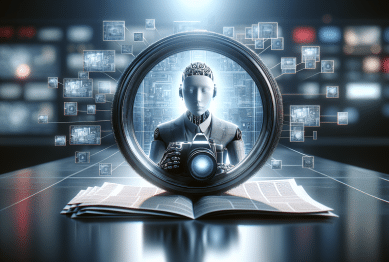Curiosity about artificial intelligence fuels countless headlines and debates. This article unpacks why AI dominates the news, the ethical questions it raises, and how emerging developments shape society, work, and even privacy. Get a helpful overview of what keeps putting AI in the spotlight.
The Power of Artificial Intelligence to Shape Headlines
Artificial intelligence has become a consistent presence in the news cycle, adapting rapidly and redefining countless sectors. The coverage is often driven by breakthroughs in machine learning, new partnerships in technology, and sweeping legislative initiatives. With its growing influence in fields from finance to medicine, AI occupies a unique position, often sparking questions about automation and the role of technology in everyday life. Many organizations see AI as the engine behind innovation, responsible for everything from smarter search engines to predictive healthcare tools. For these reasons, artificial intelligence attracts sustained public interest and analysis from journalists, researchers, and policymakers alike.
Media outlets highlight advances in AI for their transformative impact—stories about robots automating complex surgeries or chatbots powering customer service make compelling reading. These narratives strike readers as both hopeful and cautionary, blending improvements in efficiency with concerns about privacy and job displacement. Popular coverage often balances real-world applications with speculative visions of what AI could achieve in the future. This tension keeps the story evolving, especially as more industries depend on data-driven automation to remain competitive. Readers return to these stories for updates, eager for insight into how AI might change workplaces and communities next.
There’s also growing coverage around how artificial intelligence is being used to moderate online content, improve cybersecurity, and even detect misinformation—topics with urgent relevance in today’s digital landscape. As companies invest in sophisticated algorithms that can classify images, process language, or guide autonomous vehicles, questions about reliability and ethical risk become more pressing. Audiences seek trustworthy news that clarifies these issues, making the ongoing reporting of AI’s evolution essential. Media organizations are tasked with presenting developments clearly, offering critical context and helping people make sense of rapid technological change.
Ethical Dilemmas and Public Concerns
Ethical concerns around AI frequently shape news coverage, with debates moving beyond the technical to address broader societal impacts. Topics like bias in predictive policing, questions about facial recognition software, and the potential misuse of large datasets are routinely analyzed. Many of these debates stem from AI’s ability to process massive amounts of personal information, fueling concerns about surveillance and privacy. Transparency and accountability are recurring themes; experts and advocates call on companies and governments to explain how algorithms are used and to ensure they don’t reinforce existing inequalities. As more data is collected and utilized, the public’s demand for responsible AI development continues to grow.
Discrimination in algorithmic decision-making remains a perennial topic. Investigative reports highlight how AI used in hiring, lending, or law enforcement can perpetuate biases if not carefully designed and audited. As a result, calls for the creation of ethical guidelines and regulatory oversight appear frequently in credible outlets. These stories often feature voices from marginalized communities or advocacy groups, turning otherwise abstract technical discussions into urgent real-world issues. Readers are keenly interested in knowing how these technologies affect equity in areas such as housing, employment, and credit approval. The complexity of these challenges makes nuanced reporting especially important.
Many readers gravitate toward stories that explore the balance between progress and caution. For instance, news reports increasingly examine how different countries regulate AI and how new frameworks address both power and pitfalls. The global nature of AI development has created a patchwork of legislative responses, making it vital for the public to understand potential impacts. With shifting public sentiment and regulatory environments, the discussion about AI’s place in society remains active. Readers look to news organizations for impartial explanations that help them weigh benefits against risks in an era of digital transformation.
Economic Shifts and the Future of Work
The role of artificial intelligence in transforming economies is another reason it appears so frequently in the news. From tech hubs to traditional manufacturing centers, AI-driven automation and data analytics are changing how businesses operate. Reports detail how jobs evolve or disappear, with certain skills becoming more valuable as others are increasingly automated. Economists and labor experts often weigh in, highlighting challenges and opportunities as organizations retrain workers for new roles created by technology. This makes AI a regular topic in business sections and a source of lively debate in online forums.
Workforce development through upskilling and reskilling is a hot topic. For example, stories may focus on free online courses in artificial intelligence, data analysis, or robotics, showcasing resources made available through universities or partnerships between industry and government. The spotlight on lifelong learning is not just about finding new jobs but also about adapting to changes brought by automation. Organizations investing in AI must also invest in people, making this a central theme in responsible technology adoption. Readers are drawn to learning how others are managing the shift, particularly as new skills become essential across a range of fields.
Artificial intelligence has also been credited with creating entirely new categories of employment and entrepreneurship. While apprehension persists about widening inequality and job volatility, news reports explore how innovative uses of AI lead to opportunities in healthcare data analytics, green energy systems, and creative industries. The dynamic between disruption and possibility keeps readers engaged—particularly when case studies or success stories are included. Media coverage thus serves to inform, challenge assumptions, and promote a more nuanced understanding of how the digital economy is changing.
Privacy, Surveillance, and Misinformation in the Digital Age
As artificial intelligence systems become more deeply embedded in everyday digital platforms, concerns about privacy, data handling, and surveillance grow more urgent. Netflix recommendations, facial unlock features, and targeted advertising rely on AI, raising questions about how personal information is collected and shared. Reports from major outlets often analyze how companies disclose (or fail to disclose) their use of consumer data, sparking conversations about online safety and trust. These questions are particularly acute around topics like smart city surveillance or algorithmic advertising, both of which have far-reaching implications for how society operates and how news is shaped.
Misinformation is another area where artificial intelligence both helps and complicates matters. Automated content moderation and detection tools can flag misleading information and remove harmful posts, yet they’re not foolproof. News features regularly highlight both the benefits and challenges of using AI to counter deepfakes, conspiracy theories, and coordinated online misinformation campaigns. As AI becomes more sophisticated, so too do the methods used by malicious actors. This push and pull keeps the public vigilant, encouraging wider conversations about digital media literacy and institutional transparency in technology companies.
Public attitudes toward surveillance and privacy also reflect differing values across regions and generations. Some populations prioritize security and trust government use of AI, while others remain wary of encroaching surveillance or cyber risks. These attitudes influence legislation, technology design, and the direction of media coverage. By spotlighting privacy implications, journalists help people make informed choices, reinforcing the need for accessible and accurate information about how AI is developed and used.
Global Developments and Policy Trends
The global scale of artificial intelligence innovation ensures a constant flow of newsworthy developments. Countries such as the United States, China, and members of the European Union frequently announce major policy decisions, research funding, and international collaborations that ripple through technology and business sectors. These stories often highlight cross-border challenges, including debates over fair competition, talent migration, and the ethical application of AI in governance and defense. Readers turn to reputable sources for perspectives on how diplomatic alliances and rivalries shape technological progress.
Policy updates are regular features, detailing evolving standards for responsible AI development and deployment. Coverage explores national strategies for AI, outlining goals for economic growth, security, and social well-being. Legislation around data protection, intellectual property, and digital infrastructure also factors into how stories are framed. Journalists add depth by comparing national approaches, such as the European Union’s promotion of ‘trustworthy’ artificial intelligence versus market-driven models favored elsewhere. These nuanced differences inform ongoing public discussions about sovereignty, innovation, and risk management.
Another key aspect is the participation of multilateral organizations in setting global AI norms. The United Nations, World Economic Forum, and independent think tanks publish regular analysis and policy proposals designed to harmonize standards. These initiatives attract media interest, especially as governments debate the right mix of regulation and open competition. Readers interested in the future of AI policy look for up-to-date explanations and projections, appreciating coverage that tracks both local pilots and international commitments.
Your Role in Navigating Artificial Intelligence News
Staying informed about artificial intelligence requires discernment. Readers face a landscape where technical jargon, rapid advances, and shifting social attitudes all intersect. Following stories from multiple perspectives—technical, ethical, economic—offers a way to keep up without feeling overwhelmed. Reliable news sources ground exciting headlines in context, making complex ideas clear and actionable. Monitoring public debates, expert interviews, and official statements can help readers understand trends and reconsider assumptions about how technology influences daily routines.
News outlets often provide specialized explainers and expert analysis to help audiences unpack what advancements in AI mean for individuals, organizations, and nations. These guides frequently address the basic questions: what’s new, how it works, and what to expect next. By connecting local and global developments, comprehensive reporting helps frame artificial intelligence as both a rapidly evolving field and a set of issues deeply entwined with wider economic and cultural shifts. The result is more informed and empowered audiences who can distinguish hype from substance.
Engaging with news about artificial intelligence can also inspire proactive engagement. Whether through community forums, public hearings, or online education, individuals increasingly participate in the conversation about how these systems are developed and deployed. This sense of agency is essential as societies negotiate the future impacts of AI. Well-structured reporting enlightens, sparks curiosity, and encourages dialogue that benefits everyone caught in the whirlwind of technological change.
References
1. European Parliament. (n.d.). Artificial Intelligence Act. Retrieved from https://www.europarl.europa.eu/topics/en/article/20230512STO86206/artificial-intelligence-act
2. U.S. National Institute of Standards and Technology. (n.d.). AI Risk Management Framework. Retrieved from https://www.nist.gov/itl/ai-risk-management-framework
3. The Alan Turing Institute. (n.d.). Responsible AI. Retrieved from https://www.turing.ac.uk/research/impact-story/responsible-ai
4. United Nations. (n.d.). AI for Good Global Summit. Retrieved from https://aiforgood.itu.int/
5. Stanford University. (n.d.). Artificial Intelligence Index Report. Retrieved from https://aiindex.stanford.edu/report/
6. Harvard Law School. (n.d.). Algorithmic Discrimination. Retrieved from https://cyber.harvard.edu/story/2020-08/algorithmic-discrimination-and-disability-law









